Mission: The Division of Forestry, Fire & State Lands manages, sustains and strengthens Utah's forests, rangelands, sovereign lands and watersheds for its citizens and visitors.
The Division of Forestry, Fire and State Lands manages Utah's sovereign lands and provides forestry conservation and fire control activities on non-federal forest, range, and watershed lands. Although there are no state forests, approximately 30 percent of Utah is non-federal land, leaving a sizeable area on which the division administers the state's forestry laws.
During the 2015 General Session, the Legislature appropriated for Fiscal Year 2016, $28,511,100 from all sources for Forestry, Fire and State Lands. This is an 8.8 percent reduction from Fiscal Year 2015 revised estimated amounts from all sources. The total includes $2,517,900 from the General/Education Funds, an increase of 224.9 percent from revised Fiscal Year 2015 estimates.
In addition to statewide compensation and internal service fund cost increases, the following appropriation adjustments were made during the 2015 General Session:
Currently the division is putting special emphasis on the following areas:
- Providing wildland fire protection for non-federal, unincorporated lands commensurate with values at risk.
- Providing technical assistance to landowners and communities in natural resource management by utilizing the principles of multiple-use, stewardship, and ecosystem management.
- Managing the resources of sovereign lands under public trust.
The division uses the following as the top performance measures to gauge the success of its programs.
Acres of Fuel-Reduction Treatment
Hazardous Fuel Reduction: As part of the National Fire Plan (NFP), and Utah's Catastrophic Wildfire Reduction Strategy of FY 2015, the division is actively engaged in hazardous fuel reduction projects where staff and contract vendors work with private landowners across the state to reduce potential fire hazards by eliminating forest "fuels" (e.g., dead and down wood, ladder fuels, etc.) surrounding homes, community infrastructure and other values at risk from wildfire. This measure tracks the number of acres on which the division preformed hazardous fuel reduction treatments.
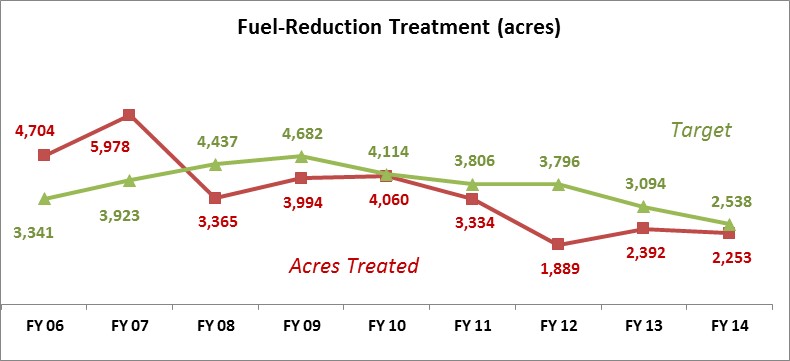
Firefighters Trained to Meet Standards
Training: This measure tracks the number of wildland firefighters trained to certified standards. The more firefighters the division can train to proper standards--including division employees, career (often urban) firefighters, and rural fire department volunteers--the better the local resources are for initial attack to control wildfires when they are small. More and better trained and qualified wildland firefighters is key to keeping the costs of wildfire low.
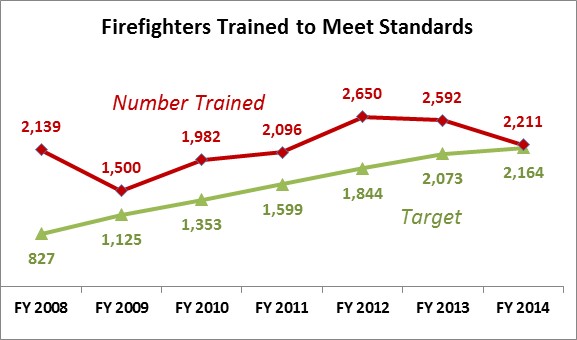
Number of Cities Qualified for "Tree City USA"
Tree City USA: This measure tracks the number of cities in Utah qualified for "Tree City USA." Tree City USA status requires certain national standards be met to receive that designation. When a city reaches this status, it is due to the efforts of division staff helping them get there and is a direct reflection on the division helping improve and maintain Utah's urban forests, which are where the vast majority of Utah citizens live.

Wildland Fires on Non-Federal Lands
Fire Season: Utah's formal fire season is May through October, so "fire season" bridges two state fiscal years, making it important to distinguish between calendar and fiscal year wildfire reporting. The fire season in Utah during calendar year 2013 was average (number of fire starts and acres burned); therefore, wildland fire costs for FY 2014 were lower than the ten-year average. The calendar year 2014 fire season, though final numbers are not yet calculated, was below average when compared to the past ten years, though FY 2015 costs will still include any wildland fires and associated costs that occur through June 2015.
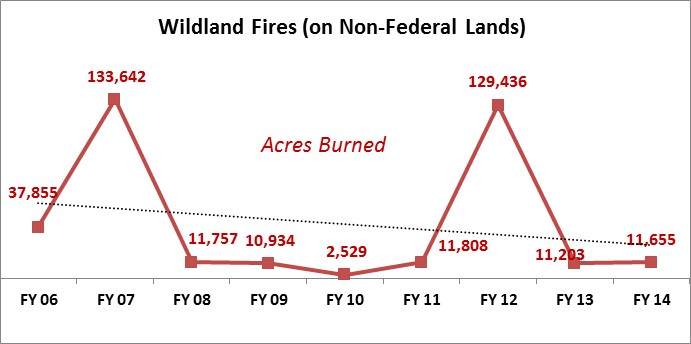
The following laws govern operation of the division:
- UCA 65A-1-1 defines "sovereign lands."
- UCA 65A-1-4 defines the division's authority.
- UCA 65A-5-1 creates the restricted Sovereign Land Management Account.
- UCA 65A-8-101 encourages private landowners in preserving, protecting, and managing forest and other lands throughout Utah.
- UCA 65A-8-105 describes division responsibility for Urban and Community Forestry programs.
- UCA 65A-8-202 requires the division to abate fires on all state-owned lands, but owning agencies shall recognize the need and responsibility for sharing the costs and shall annually allocate funds to the division in amounts determined to be proportionate to the costs of providing a basic level of fire protection.
- UCA 65A-9-1 makes the division responsible for efficient management of range resources on lands it administers.
- UCA 65A-10-1 allows the division to exchange, sell, or lease sovereign lands but only in quantities and purposes that serve the public interest and so not interfere with the public trust.
- UCA 65A-10-3 requires the division to develop plans to resolve disputes over sovereign land boundaries.
- UCA 65A-10-8 requires a comprehensive plan for the Great Salt Lake.
The division receives federal funds, dedicated credits, appropriations from the Sovereign Lands Management Restricted Account and the General Fund, as well as funding from the Wildland Fire Suppression Fund.
A large sum of federal dollars are used for "Forest Legacy" projects (budgeted in the Forest Management Program) which consists of identifying willing private land owners interested in protecting environmentally important private forest lands that are threatened by conversion to non-forest uses. Most of these funds are used to purchase conservation easements. Other federal funds are used for forestry assistance to private landowners, forest health, and urban and community forestry.
The division's dedicated credits come mostly from reimbursement for project labor, including firefighting, by the Lone Peak Conservation Center.
Special Funds
The division manages the expendable trust fund known as the Wildland Fire Suppression Fund (UCA 65A-8-204). Counties may contribute to the fund by agreeing to specific terms set in statute and the state must match the county's contributions. In FY 1998 the Legislature added $1.5 million to the division's General Fund base to match county payments. In FY 2001, 2003, and 2009, the fund did not have sufficient money to pay all obligations. To avoid prorating funds, the Legislature made a one-time appropriation of $5 million in FY 2001, $3.2 million in FY 2003, and $4 million in FY 2009 directly to the fund. In the 2006 General Session, the Legislature passed S.B. 65, which allows counties to exempt certain lands and values from the calculation. Because of this, division management anticipates a reduction in the amount of revenues coming into the fund. Currently all counties, except Rich, Salt Lake, Summit, Wasatch, and Weber, participate in the program. Additional information about the fund:
- Also known as the "Insurance Fund"
- Capped at $8 million,
- Eligible lands include forest, range, and watershed lands in unincorporated areas of counties, except federal or state lands,
- Counties pay a premium based on acreage and taxable value of real property in unincorporated areas. The state matches their payments.
The figure below shows the activities of the Sovereign Lands Management Restricted Account over time, the appropriated amount for the current fiscal year, as well as the average revenues, expenditures, and balances.
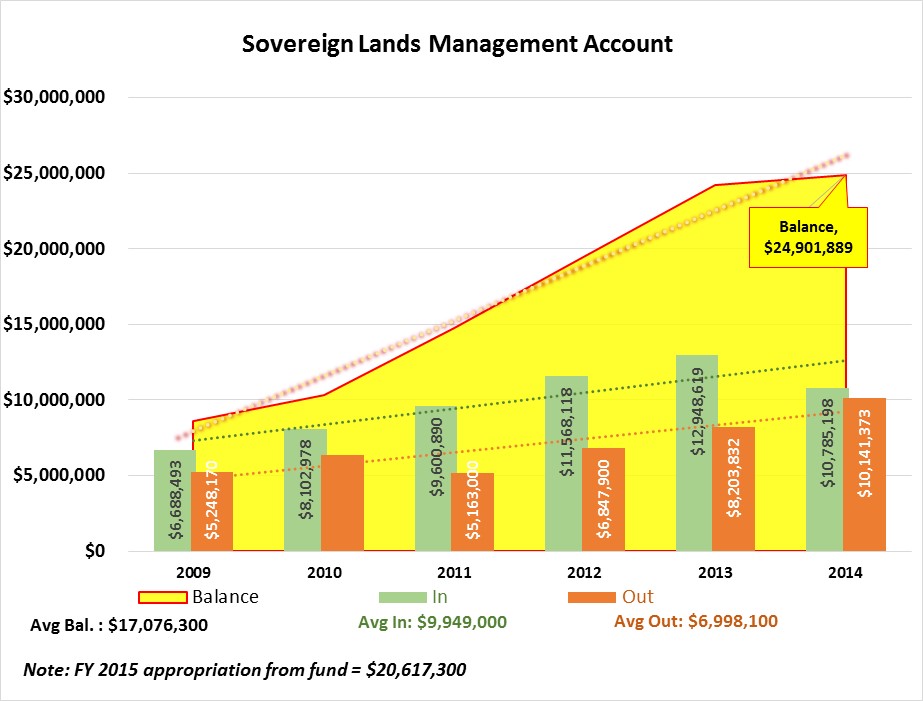
The following figure shows the account balances with projections based on certain assumptions.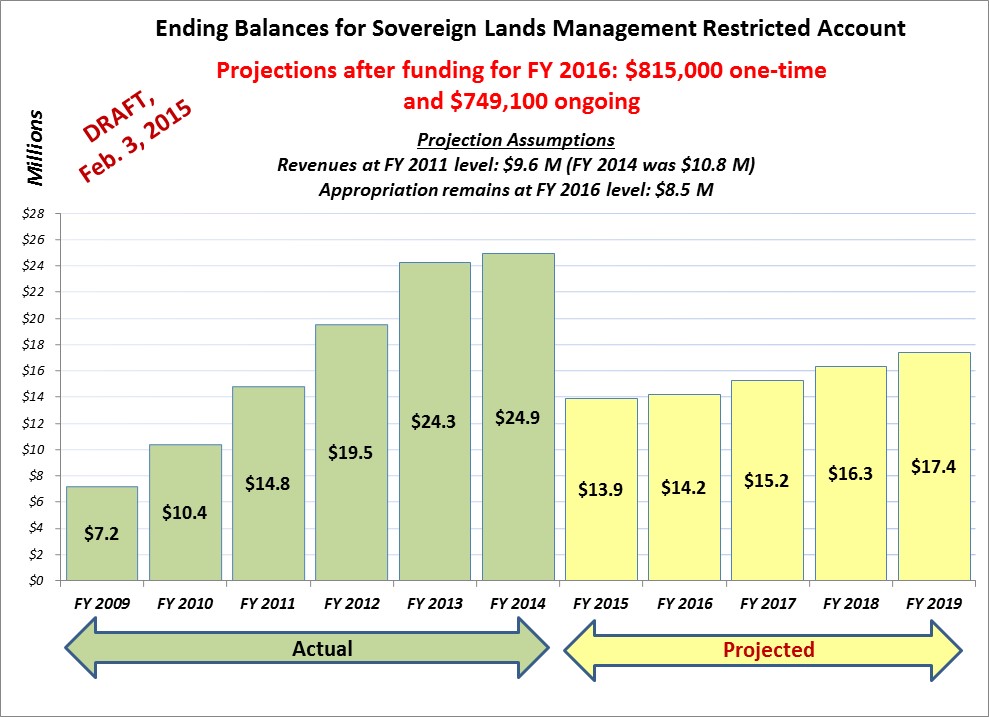
COBI contains unaudited data as presented to the Legislature by state agencies at the time of publication. For audited financial data see the State of Utah's Comprehensive Annual Financial Reports.